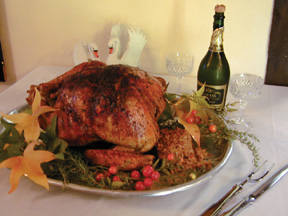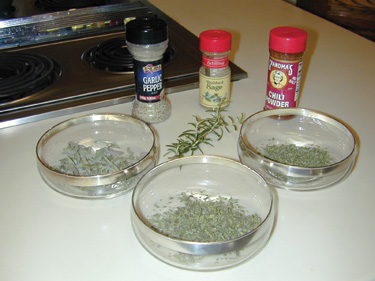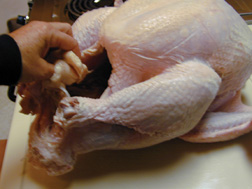 Bay
CrossingsCuisine
Bay
CrossingsCuisine
Herb
& Spice Rubbed Turkey
By
Mary Swift-Swan
November is turkey month. In America, cooking
turkey at Thanksgiving is a tribute to help given by the Indians
who showed English colonists how to survive by growing crops and
hunting for meat in the new world. Wild turkey was and is hard to
successfully hunt. Fortunately Turkey is easy to raise. Start to
finish it only takes about 4 hours to cook. Triptafan, a chemical
we get from eating turkey, is so relaxing it could put a few drugs
off the market. It makes it easy to relax and enjoy time spent
with friends and family after a Thanksgiving dinner. To cook a
Turkey at home there are a few decisions to first make:
1.
Fresh or Frozen Turkey
2. Sweet or Savory flavor
3. To Stuff or not to Stuff |
Fresh turkey is not frozen as hard as a frozen turkey. They thaw
faster. Make room in the refrigerator to allow the turkey to thaw
slowly without becoming a science experiment. For a frozen turkey
14-23 lbs, expect it to take three days. If a same size turkey is
"fresh frozen" it would take two days. Our choice is a
frozen turkey. That gave me three days to create this recipe.
 The following savory recipe was inspired by the
bounty from a family garden of sage, thyme and marjoram, plus
rosemary that had a growing spurt this year.
The following savory recipe was inspired by the
bounty from a family garden of sage, thyme and marjoram, plus
rosemary that had a growing spurt this year.
Bread Stuffing is dryer if made on the stovetop
or in a casserole verses in the bird. Add bits of giblets and
juices from the roasting pan to provide a flavorful yet crispy
stuffing. Instead of bread stuffing, a favorite is to use apple
and onion. These draw out strong flavors and adding back sweet and
spicy ones. This technique works well with wild as well as frozen
domestic bird.
Pre-heat
oven to 350 degrees
1 Turkey (14-23 lbs, 1.25 lb per person serves 8 with
leftovers)
Slices of lemon to lightly rub the bird, then dry off
Course salt (sea or kosher) sufficient to lightly rub the
bird
Herb and Spice Mash
2 Tb ea Dried Sage, Marjoram & Thyme
1 tsp ea Dried Rosemary & fennel crushed in a mortar
with pestle
1/2 tsp ea Garlic Powder & celery salt
2/3 Stick of Unsalted butter (softened)
Stuff for flavor
2 ea medium Onions & Apples cut into pieces
1 sprig of fresh Rosemary
In bottom of Pan
12 oz Spring water |
While the oven is heating, remove from the
wrapper the turkey. Pull out the packet of giblets and the neck
bone stuffed in the cavity of the bird, save to use for stock or
gravy. Cut off the tail and pull the legs free of the truss. Rinse
the bird inside and out. Remove any fat that can easily be pulled
off. If the bird was frozen, rub inside and out with a section of
cut lemon to freshen the taste. Let the juice of the fresh lemon
sit undisturbed on the bird for ten minutes. Pat the bird dry
inside and out, changing paper towels often to ensure a dry
result. Then rub the bird inside and out with a light mixture of
course salt.
 Next mix softened butter with the herbs and
remaining seasonings forming a mash using the back of a spoon and
set aside. Work your hand between the skin and bird gently and
slowly to lift and separate the skin. Stop when it appears you
might tear the skin. Next rub the herb & spice mash inside the
bird cavity and neck opening, then between the skin and body of
the bird. Place half of the apple and onion into the cavity. Put a
fresh sprig of rosemary at mid point. Fill in the remainder of the
cavity with apple and onion. Put the legs back into the truss. The
cavity does not need a tight closure with this type of loose
stuffing. Finish by filling the neck cavity with the remaining
apple and onion sections and skewer neck close. Finally rub the
mash on the outside of the bird.
Next mix softened butter with the herbs and
remaining seasonings forming a mash using the back of a spoon and
set aside. Work your hand between the skin and bird gently and
slowly to lift and separate the skin. Stop when it appears you
might tear the skin. Next rub the herb & spice mash inside the
bird cavity and neck opening, then between the skin and body of
the bird. Place half of the apple and onion into the cavity. Put a
fresh sprig of rosemary at mid point. Fill in the remainder of the
cavity with apple and onion. Put the legs back into the truss. The
cavity does not need a tight closure with this type of loose
stuffing. Finish by filling the neck cavity with the remaining
apple and onion sections and skewer neck close. Finally rub the
mash on the outside of the bird.
 Careful to not disturb the rub too much, place
the bird breast down in a V rack, set inside a roasting pan. Then,
insert a knife cutting a two-inch slice on either side of the back
and on each thigh. Again, as far as you can without tearing the
skin, separate the skin from the bird using these slices as points
of entry. Rub a layer of herb and spice mash between the skin and
body followed by rubbing the outside of the back. Leave the bird
breast down in the V rack.
Careful to not disturb the rub too much, place
the bird breast down in a V rack, set inside a roasting pan. Then,
insert a knife cutting a two-inch slice on either side of the back
and on each thigh. Again, as far as you can without tearing the
skin, separate the skin from the bird using these slices as points
of entry. Rub a layer of herb and spice mash between the skin and
body followed by rubbing the outside of the back. Leave the bird
breast down in the V rack.
 Tent the bird with foil to avoid early or
excessive browning. To tent - loosely cover with overlapping foil
strips leaving air between the foil and the bird. Secure the sides
of the tent by wrapping the foil around the outer edges of the
rack that stick up above the pan. Place in the oven. Last add
water to about 1/4" after in the oven to prevent drippings
from burning and cook a moist bird. Close the oven door and roast
without opening the oven door, up to the last 45 minutes,
according to the chart below.
Tent the bird with foil to avoid early or
excessive browning. To tent - loosely cover with overlapping foil
strips leaving air between the foil and the bird. Secure the sides
of the tent by wrapping the foil around the outer edges of the
rack that stick up above the pan. Place in the oven. Last add
water to about 1/4" after in the oven to prevent drippings
from burning and cook a moist bird. Close the oven door and roast
without opening the oven door, up to the last 45 minutes,
according to the chart below.
Forty-five minutes before the bird is done - remove from the oven
and place on top of the stove. Close the oven to keep it hot.
Remove the tent. Turn the bird with two forks one from each end.
Redress the rub on breast and place back in the oven. Begin
basting after 10 minutes and continue every 10 minutes with juices
from the pan. When the oven is open baste quickly so the bird
won't cool.
Turkey
weight Oven Cooking time Cooking time
W/giblets temp w/o Stuffing w/stuffing |
9-13
lb 350 1 1/2 - 2 1/4 hr 2 - 2 3/4 hr
14-23 lb 350 2-3 hr 2 2/3 - 3 2/3 hr
24-27 lb 325 3 - 3 3/4 hr 3 3/4 - 4 1/2 hr |
A key challenge in cooking a truly wonderful
Turkey is the internal temperature should be 160 for the white
meat and 170 for the dark meat. When cooking till the dark meat is
done the breast meat is similar to flavorless sawdust. Cooking the
turkey initially with the breast down will result in a moist bird
that is fully cooked. The upper portion of the oven is hotter.
During the last phase, the upper oven cools by opening it to
baste. Check the temperature with a meat thermometer. Avoid
punching too many holes into the bird while checking the
temperature in the final 35 minutes. Once a hole is made, reuse
it.
 When done, rest the bird for 30 minutes under a
tin foil tent prior to cutting. This allows juices and full flavor
to be pulled into the meat. Remove from the rack and place on a
platter. Remove the apples and onions to allow it to cool faster.
They can be added to the casserole or stove top stuffing or toss
them. If the meat is cut when too hot, the juice can run out of
the bird taking much of the flavor with it. Resting the bird is
the perfect time to make gravy using the pan juices (minus oil)
and finish potatoes or stuffing to compete the meal. A special
touch is to provide a small bowl of extra herb and spice mash for
friends and family who do not want gravy. For gravy, stuffing or
mash potato recipes write info@Bay Crossings.com
When done, rest the bird for 30 minutes under a
tin foil tent prior to cutting. This allows juices and full flavor
to be pulled into the meat. Remove from the rack and place on a
platter. Remove the apples and onions to allow it to cool faster.
They can be added to the casserole or stove top stuffing or toss
them. If the meat is cut when too hot, the juice can run out of
the bird taking much of the flavor with it. Resting the bird is
the perfect time to make gravy using the pan juices (minus oil)
and finish potatoes or stuffing to compete the meal. A special
touch is to provide a small bowl of extra herb and spice mash for
friends and family who do not want gravy. For gravy, stuffing or
mash potato recipes write info@Bay Crossings.com
Have a Happy Turkey Day!